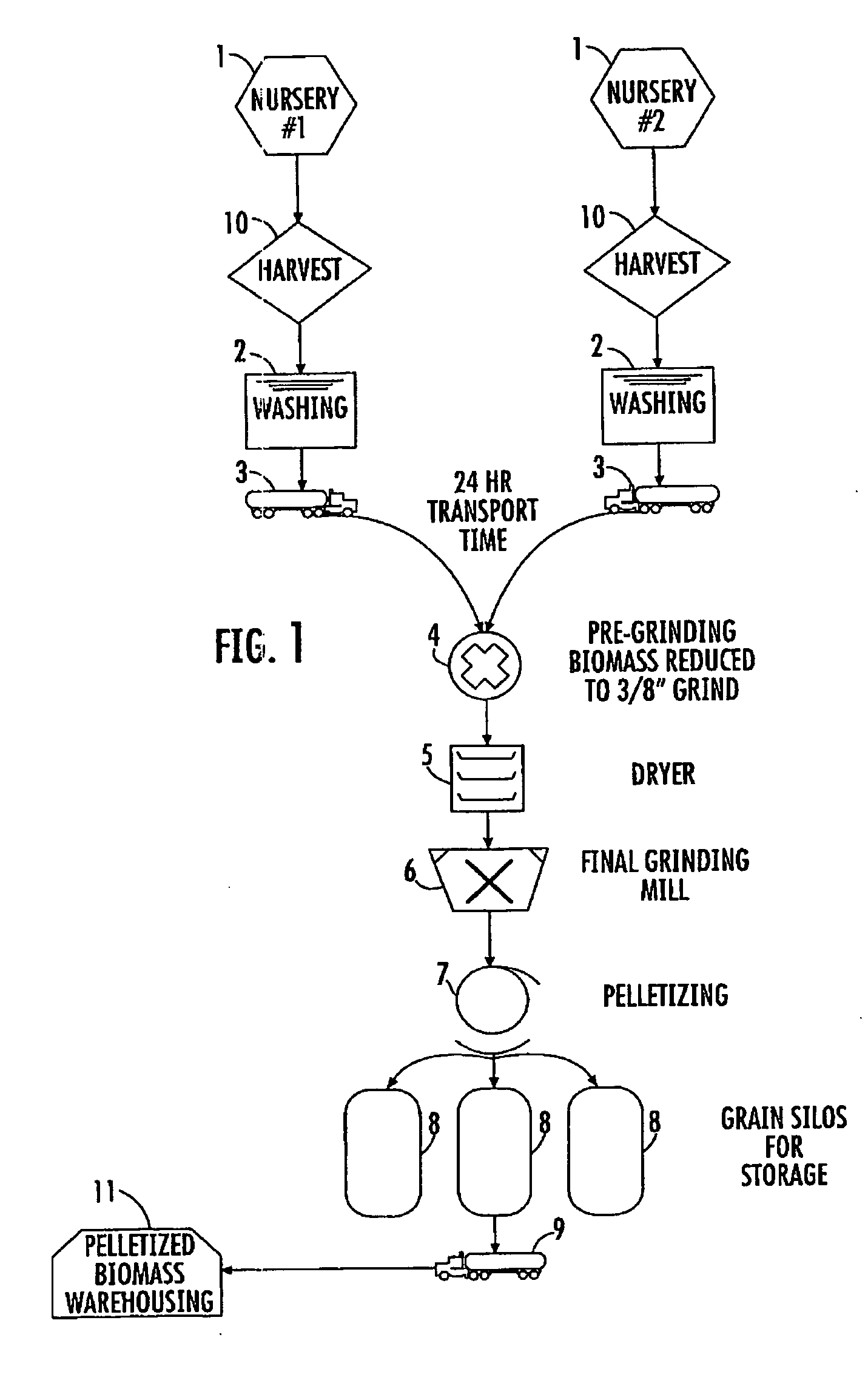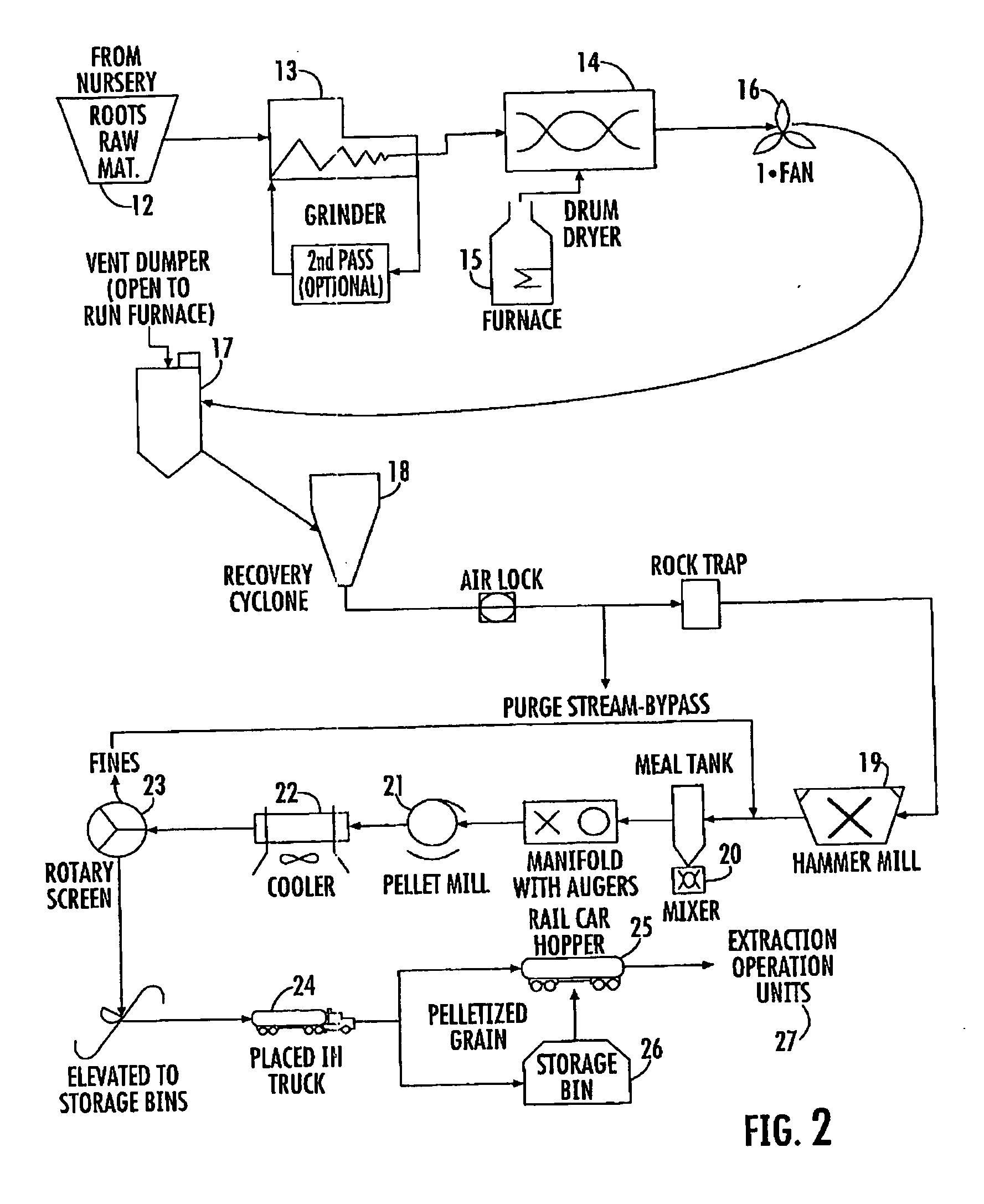Harvesting and pelletizing yew biomass for extraction of taxanes and other natural products
a technology of yew biomass and extraction of taxanes, which is applied in the direction of biocide, plant/algae/fungi/lichens ingredients, other domestic articles, etc., can solve the problems of poor solvent contact and solvent extraction problems, and achieve the effect of efficient and economical
- Summary
- Abstract
- Description
- Claims
- Application Information
AI Technical Summary
Benefits of technology
Problems solved by technology
Method used
Image
Examples
example 1
Pelletizing Process
[0085] 1. 2000 grams of dry ground Yew tree root biomass (powder). [0086] 2. 200 g water added to the Yew biomass. [0087] 3. The biomass and water were mixed in a HOBART blender with eccentric drive / paddle. [0088] 4. The die is first purged with oats, forming pelletized oats. [0089] 5. The wetted biomass was run through a CPM ‘CL3’ Laboratory pellet mill. This m had a 3 HP motor (220 Volts). The temperature of the resulting pellets wereapproximately 160° F. The pellets were dark in color, ranging in length of about ½ inch to 1 inch. [0090] 6. After 20 minutes, the moisture content of the pellets was approximately 10.3%. After 30 minutes, it was approximately 10.4%. The bulk density of the pellets was 39 lb. / ft3* The bulk density of the biomass powder was approximately 18 Ibs / ft3, Capacity tests were run on the pellet mill to determine the mill's capacity for the biomass material. For example, to produce ⅛ inch pellets, the capacity for the mill was 117 lbs / hr.
example 2
Additives
[0091] In some instances, additives can be used to facilitate production of pellets suitable for taxane extraction. The following examples describe an additive (Guar Gum) that can be added to the wetted biomass. Each pelletizing run followed the general protocol shown in Example 1, To evaluate the amount of fines, the die was heated beforehand.
[0092] b 1% Guar Gum
[0093] Guar gum run: 3 / 16″ pelletizing; 2000 g of ground Yew root biomass; 200 g H2O; 20 g guar gum;
[0094] Guar Gum Source—*non-food grade Rawtec UFF-MV (5 / 21 / 01 RX 1036)
[0095] Temperature higher: more fines in 155° F.; 128 lb / lir
[0096] Bulk density: 40 lb / ft3; and
[0097] Wgt. fines 208 g; wgt pellets 1822 g; 10.2% fines; 90% conversion.
[0098] 1 / 2% Guar Gum
[0099] Guar gum run: ⅛″ pelletizing;
[0100] 2000 g of ground Yew root biomass; 200 g H2O;
[0101] 10 g guar gum (=½%) (added as powder);
[0102] Temp 150° F. to 163° F.;
[0103] Rate: 136 lb / hr.;
[0104] Wgt. pellets: 1894 g; wgt fines. 139 g; or 7% fines; an...
example 3
Extraction of Taxanes From Pellets
[0117] A series of experiments were run to confirm that paclitaxel and other taxanes survive the pelletizing process of the present invention. Specifically, Yew pellets were extracted using hot methanol in a Soxhlet apparatus: ⅛″ pellets (no additives), 3 / 1″ pellets (no additives), and non-pelletized biomass powder (from which the pellets were made). Table 3 shows the recovery of taxanes.
TABLE 3Soxhlet Thimble Wgt. GramsExp. Run No.TareGrossMass of Biomass112.547.835.3 g startingmaterial213.250.737.5 g dry groundbiomass314.373.859.5 g ⅛″ pellets,no additives413.068.255.2 g ⅛″ pellets,no additives512.874.761.9 g 3 / 16″pellets, no additives611.170.259.1 g 3 / 16″pellets, no additives
[0118] HPLC analysis showed good recovery of total taxanes approximately (approximately 0.02% w / w) for both pellets and non-pellets. HPLC analysis also showed good recovery of paclitaxel (approximately 0.01% w / w) for both pellets and non-pellets. These tests showed no sign...
PUM
| Property | Measurement | Unit |
|---|---|---|
| density | aaaaa | aaaaa |
| diameter | aaaaa | aaaaa |
| temperature | aaaaa | aaaaa |
Abstract
Description
Claims
Application Information
 Login to View More
Login to View More - R&D
- Intellectual Property
- Life Sciences
- Materials
- Tech Scout
- Unparalleled Data Quality
- Higher Quality Content
- 60% Fewer Hallucinations
Browse by: Latest US Patents, China's latest patents, Technical Efficacy Thesaurus, Application Domain, Technology Topic, Popular Technical Reports.
© 2025 PatSnap. All rights reserved.Legal|Privacy policy|Modern Slavery Act Transparency Statement|Sitemap|About US| Contact US: help@patsnap.com


